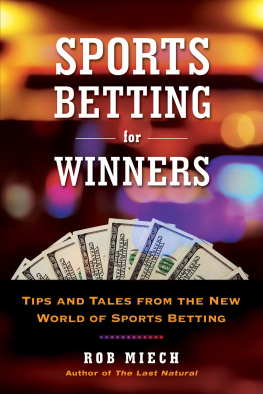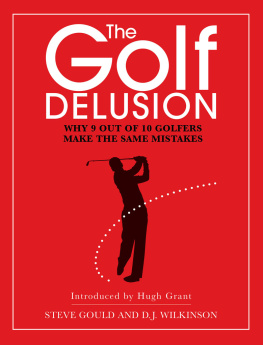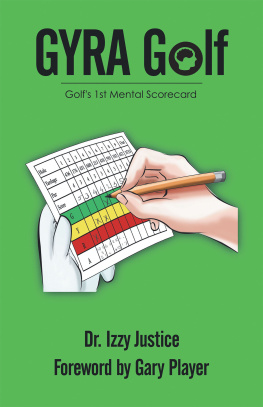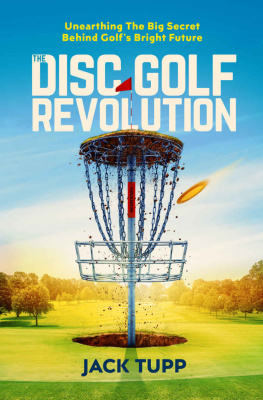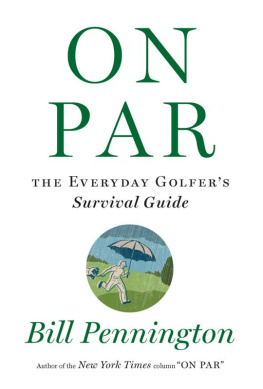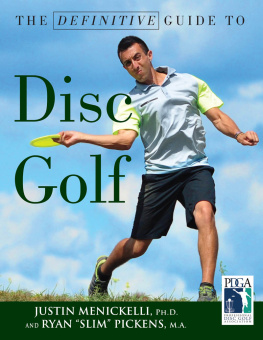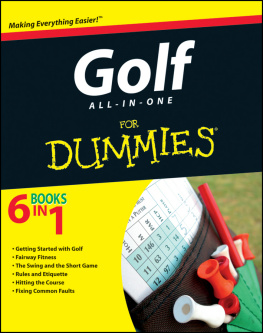MONEY GOLF
Other Books by Michael K. Bohn
The Achille Lauro Hijacking:
Lessons in the Politics and Prejudice of Terrorism
Nerve Center:
Inside the White House Situation Room
MONEY GOLF
600 YEARS OF
BETTIN ON BIRDIES
MICHAEL K. BOHN

FOR MY SON, ERIK
Copyright 2007 by Michael K. Bohn.
Published in the United States by Potomac Books, Inc. All rights reserved. No part of this book may be reproduced in any manner whatsoever without written permission from the publisher, except in the case of brief quotations embodied in critical articles and reviews.
Library of Congress Cataloging-in-Publication Data
Bohn, Michael K.
Money golf: 600 years of bettin on birdies / Michael K. Bohn.1st ed.
p. cm.
Includes bibliographical references and index.
ISBN 978-1-59797-031-0 (alk. paper)
1. GolfBettingHistory I. Title.
GV979.B47B65 2007
796.352dc22
2006030803
ISBN 978-1-59797-032-7 (paperback)
Printed in the United States of America on acid-free paper that meets the American National Standards Institute Z39-48 Standard.
Potomac Books, Inc.
22841 Quicksilver Drive
Dulles, Virginia 20166
First Edition
10 9 8 7 6 5 4 3 2 1
CONTENTS
ILLUSTRATIONS
Old Palm Golf Clubs Betting Hole
Dagwood Readies Himself for Money Golf
The Golfers by Charles Lees
Money Golf in Scotland, 1859
Andra Kirkaldy and Archie Compston
Bobby Jones and Betting Partners
A Womans View of Golf Betting, 1920
Mysterious Montague
Sam Snead and Ben Hogan
Golfs Oil Artist, Dutch Harrison
Babe Didrikson Zaharias, A Betting Lady
Betting Presidents, Eisenhower and Nixon
Arnold Palmer Loses a Bet
East Potomac Park, Washington, D.C.
Lee Trevino Wins with Dr Pepper
Sure Bets, Sorenstam and Davies
Phil the Thrill Mickelson
John F. Kennedy
Two Betting Men, Woods and OMeara
PGA Tour Caddie Betting
Embarrassed Losers, Stewart and Funk
FOREWORD
THE GOLF GODS WANT US TO PLAY THE GAME with something at stake. I have always played informal rounds with some money on the linea couple bucks when I was in high school but a little more after I turned pro. Its just the nature of the game. Sure, I still get a thrill from hitting an iron shot stiff on 18, but its more fun winning $20 doing it. Besides, I can needle my friends with more gusto if I use their money to buy lunch for everyone after the round.
I learned about money golf when I was teenager in Richmond, Virginia. My father was an assistant pro at Meadowbrook Golf Club, and I loved the game from the start. When I was 13 years old, one of the club members, a local car dealer, asked me to partner with him in matches against his friends. At first I had no idea the men were betting, but I enjoyed the challenge of playing them. I soon began to appreciate the art of money golf, however, especially later, when my partner bought me my first car in 1965, when I was 15. It was a nice thank you for helping him win so many bets. I have liked playing for a little something ever since.
I turned pro in the fall of 1971 and had a good first season the following year on tour, when I broke the rookie earnings record. My career really took off in 1973, though, when I won twice and ended up fifth on the money list. Thinking back, the money games I played during practice rounds helped me improve my game. As Mike describes in , Bert Yancey and I played Arnold Palmer and Tom Weiskopf almost every week in 73 with a little spending money at stake. Tom won the British Open that year and five other tournaments, but Bert and I beat the two of them like tomtoms. We kept playing those games for years, and I loved taking Arnies cash whenever I had the chance.
Back in the 1970s, the PGA Tour didnt have the carnival of events now scheduled during the early part of each tournament week. Playing practice rounds for a friendly wager was fun, and we looked forward to those games. Nicklaus even sent me telegrams to make sure I was available for a game. Hed write, I got Hale Irwin against you and Raymond Floyd.
I want to make one thing clear: I never bet during the actual tournament and no one should. Practice round matches, however, set professional golf apart from other sports. You dont see the Yankees and Red Sox playing a couple of casual innings before a three-game series. They are all business, all the time. We professional golfers, on the other hand, know how to separate business from pleasure in our sport.
At my home course, Preston Trail in Dallas, I have played money golf over the years with my friends, just as millions of other golfers do every weekend. The competition has always been more important than the money. But some of our get-even bets on nine and 18 were scary enough to make me glad to get back out on tour the following week.
I play golf by the rules, try my best to be a gentleman during matches, and always play for moneybut I never bet more than I am comfortable losing. Just as Sam Snead once said, the game might be boring without something at stake.
Lanny Wadkins
Dallas, Texas
ACKNOWLEDGMENTS
MANY PEOPLE HELPED MOVE THIS PROJECT ALONG, especially in the beginning when I was struggling to define its scope and message. One in particular is Archie Baird, director of the Heritage of Golf Museum in Gullane, Scotland. He was the first to put betting on golf in a historical perspective, one that permitted me to follow the thread of gentlemanly wagering through the hundreds of years of the games heritage. David Hamilton, a British golf historian, also helped, as did Dick Donovan, a noted American golf book collector and seller. Closer to home, I am indebted to Pete Van Pelt, PGA, the general manager and director of golf at Mount Vernon Country Club, for his interest and timely phone calls to contributors. Dick Johns, executive director of the PGA of Americas Middle Atlantic Section, was very helpful, as were Donald Dell and Mike Milthorpe at SFX Sports.
I wish to thank Kevin Cuddihy and Sam Dorrance at Potomac Books for their help and support. I am also grateful to Sarah Flynn for her critical advice on the books structure and narrative. Many thanks go to Dick Myers and Walker Merryman for reading the draft manuscript. Thanks also to my wife, Elin, for her unflagging understanding of my single-minded pursuit of a finished manuscript.
I interviewed too many people to name them all here, but I must single out a few for the important guidance and information they gave me at critical points in my research: Ben Wright, Peggy Kirk Bell, Charlie Mechem, and Bob Rosburg.
Thanks also to several golf professionals at my club, Mount Vernon Country Club of Alexandria, Virginia, for helping with the cover of the book: Bryan Armstrong, PGA, head professional; Ron Millner, PGA, director of instruction; Terry Hummel, PGA, professional emeritus; and Liz Cooper, PGA apprentice.
I must acknowledge the patience of my regular Saturday golf buddies who grew weary of listening to the books progress: Bill Crawdad Meares, Steve The Defender Pickard, Allen Answer Man Benn, Bill Pipeline Gute, Bud G-Man Small, Delaware Joe Resende, Classy Jack Burton, Woody Wiedemer, and one of the nicest men I know, Lee Coogan.
At the cost of sounding crassly commercial, I must also praise the resources of the used-book vendors at Amazon.com. The extraordinary range of golf books available there allowed me to find hundreds of valuable sources. Experts have always said nonfiction writers need their own library, and Amazon now makes establishing a collection financially achievable.
Next page

